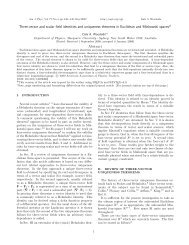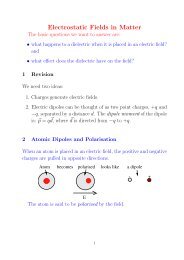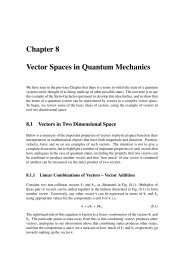Astronomy Diagnostic Test - Physics and Astronomy
Astronomy Diagnostic Test - Physics and Astronomy
Astronomy Diagnostic Test - Physics and Astronomy
Create successful ePaper yourself
Turn your PDF publications into a flip-book with our unique Google optimized e-Paper software.
<strong>Astronomy</strong> <strong>Diagnostic</strong> <strong>Test</strong> Southern Hemisphere Edition Version 2This test is designed to find out what you know about various astronomicalconcepts.It will not be used for grading purposes.Please read each question carefully then indicate what you think by selecting themost appropriate option.If you do not know the answer to the question please select the I do not know option.There are 30 questions - please read <strong>and</strong> complete them all.It does not matter if you do not know the answer - simply circle I do not know.And remember, there are prizes of ‘iTunes’ vouchersof $50, $30 <strong>and</strong> $20 for class completions of thisQuestionnaire. Up to three prizes per class will beawarded if more than 80% of the class completes thisquestionnaire.Name: ____________________________________________(Please Print)Your email address: ____________________________________________(….so we can tell you if you have won an iTunes voucher)Year: 9 10 11 12 (Please Circle)School: ____________________________________________(Please Print)How many times have you done this test?1 2 3 4 5 6 (Please Circle)
<strong>Astronomy</strong> <strong>Diagnostic</strong> <strong>Test</strong> For each question, check the box of the option you think best. Which sentence best describes why daytime <strong>and</strong> nighttime happen? The Earth’s revolution about the Sun causes night <strong>and</strong> day. The Earth orbits the Sun by day <strong>and</strong> the Moon by night. The rotation of the Earth causes day <strong>and</strong> night. The Earth rotates at the centre while the Sun moves around the Earth. The Moon orbits the Earth daily <strong>and</strong> blocks sunlight at night. I do not know the answer to this question. Imagine you are out in space looking down on the Earth, the Moon <strong>and</strong> the Sun. Which sentence best describes how they would move? The Moon <strong>and</strong> the Earth orbit the Sun independently. The Moon orbits the Earth <strong>and</strong> together they orbit the Sun. The Earth is at the centre <strong>and</strong> the Sun <strong>and</strong> Moon orbit the Earth. The Earth orbits the Sun during the day <strong>and</strong> the Moon at night. The Moon, the Earth <strong>and</strong> the Sun move around in the same orbit. I do not know the answer to this question. Janine looked for the Moon one week. Here is what she saw: Which sentence best describes why Janine saw the Moon these different shapes. The different phases that we see are caused by: The relative positions of the Sun, Earth <strong>and</strong> the orbiting Moon. The shadow of the Earth falling on different parts of the Moon. Clouds on the Earth covering different amounts of the Moon. Sunlight reflecting from the Earth back to the orbiting Moon. I do not know the answer to this question. Page 2
<strong>Astronomy</strong> <strong>Diagnostic</strong> <strong>Test</strong> The diagram above shows the Earth <strong>and</strong> Sun as well as five different possible positions for the Moon. Which position of the Moon would cause it to appear like the picture below when viewed from Earth? A B C D E I do not know the answer to this question. Which sentence best describes why summer <strong>and</strong> winter happen. The Earth’s tilted axis makes one hemisphere of the Earth closer to the Sun so that it is summer while the other half is further away from the Sun making it winter. During summer the hot side of the Sun faces Earth making it warmer while in winter the cool side of the Sun faces Earth making it cooler. During winter clouds block the light coming from the Sun weakening it while in summer there are few clouds which means the light coming from the Sun is stronger. The Earth’s tilted axis means that one hemisphere has more direct sunlight <strong>and</strong> longer days making it summer while the other hemisphere experiences winter. The Sun moves to make one side of the Earth hot for six months making summer while the other side of the Earth is cool <strong>and</strong> experiences winter. I do not know the answer to this question. Page 3
<strong>Astronomy</strong> <strong>Diagnostic</strong> <strong>Test</strong> Use the drawing below to answer the next TWO questions. If you could see stars during the day, the drawing above shows what the sky would look like at noon on a given day. The Sun is at the highest point that it will reach on this day <strong>and</strong> is near the stars of the constellation Gemini. What is the name of the constellation that will be closest to the Sun at sunset on this day? Leo Taurus Gemini Pisces Cancer I do not know the answer to this question. This picture shows the position of the stars at noon on a certain day. How long would you have to wait to see Gemini at this same position at midnight? 12 hours 24 hours 6 months 1 year Gemini is never seen at this position at midnight. I do not know the answer to this question. You look to the eastern horizon as the Moon first rises <strong>and</strong> discover that it is in Athe full moon phase. Which picture shows .what the moon will look like when it is at its highest point in the sky, later that same day? D A . B C D E I do not know the answer to this question. B.E.C.Page 4
<strong>Astronomy</strong> <strong>Diagnostic</strong> <strong>Test</strong> You are located in New South Wales, Australia at noon on the first day of October. How will the altitude of the Sun at noon be different two weeks later? It will have moved toward the North. It will have moved to a higher altitude. It will stay in the same altitude. It will have moved to a lower altitude. It will have moved toward the west. I do not know the answer to this question. From your current location, imagine that you see Mars rising in the east at 6:30 pm. Six hours later what direction would you face (look) to see Mars when it is highest in the sky? toward the north toward the south toward the east toward the west directly overhead I do not know the answer to this question. Imagine that Earth’s axis of rotation was upright with no tilt. How would this affect the seasons? We would no longer experience a noticeable difference between the seasons. We would still experience seasons, but the difference would be less noticeable. We would still experience seasons, but the difference would be more noticeable. We would continue to experience seasons in essentially the same way we do now. I do not know the answer to this question. How does the Sun produce the energy that heats our planet? The gases inside the Sun are burning <strong>and</strong> producing large amounts of energy. Gas inside the Sun heats up when compressed, giving off large amounts of energy. Heat trapped by magnetic fields in the Sun is released as energy. The core of the Sun has radioactive atoms that give off energy as they decay. Hydrogen is combined into helium, giving off large amounts of energy. I do not know the answer to this question. The Big Bang is best described as: The event that formed all matter <strong>and</strong> space from an infinitely small dot of energy. The event that formed all matter <strong>and</strong> scattered it into space. The event that scattered all matter <strong>and</strong> energy throughout space. The event that organised the current arrangement of planetary systems. The event that formed all matter <strong>and</strong> space at the beginning of time. I do not know the answer to this question. Page 5
<strong>Astronomy</strong> <strong>Diagnostic</strong> <strong>Test</strong> Which of the following ranks locations, from closest to Earth to farthest from Earth? the Sun, the Moon, the edge of our solar system, the Southern Cross, the edge of our galaxy the Moon, the Sun, the edge of our solar system, the Southern Cross, the edge of our galaxy the Sun, the Southern Cross, the Moon, the edge of our galaxy, the edge of our solar system the Moon, the Southern Cross, the Sun, the edge of our solar system, the edge of our galaxy the Southern Cross, the Moon, the Sun, the edge of our galaxy, the edge of our solar system I do not know the answer to this question. Consider the six different astronomical objects (A-F) shown below. A. The Solar SystemB. The SunC. JupiterD. Andromeda GalaxyE. Galaxy ClusterF. NebulaWhich of the following is the best ranking (from smallest to largest) for the size of these objects? C
<strong>Astronomy</strong> <strong>Diagnostic</strong> <strong>Test</strong> What is a star? a hot ball of gas that produces energy by combining atoms into heavier atoms a ball of gas that reflects light from another energy source a bright point of light visible in Earth’s atmosphere a hot ball of gas that produces energy by burning gases a hot ball of gas that produces energy by breaking apart atoms into lighter atoms I do not know the answer to this question. Which one property of a star will determine the rest of the characteristics of that star’s life? brightness temperature mass colour chemical makeup I do not know the answer to this question. Current evidence about how the universe is changing tells us that … We are near the centre of the universe. Galaxies are exp<strong>and</strong>ing into empty space. Groups of galaxies appear to move away from each other. Nearby galaxies are younger than distant galaxies. I do not know the answer to this question. Stars begin life as a cloud of gas <strong>and</strong> dust. a piece that comes from a star or planet. a white dwarf. matter in Earth’s atmosphere. a black hole. I do not know the answer to this question. When the Sun reaches the end of its life, what will happen to it? It will turn into a black hole It will have lost its outer layers, leaving its core behind It will explode, destroying Earth It will not die due to its mass I do not know the answer to this question. How did the planets orbiting our Sun form? The planets <strong>and</strong> the Sun formed at the time of the Big Bang. The planets were captured by the Sun’s gravity. The planets formed from the same materials as the Sun. The planets formed from the fusion of hydrogen in their cores. I do not know the answer to this question. Page 7
<strong>Astronomy</strong> <strong>Diagnostic</strong> <strong>Test</strong> Which of the following would make you weigh half as much as you do right now? Take away half of the Earth’s atmosphere. Double the distance between the Sun <strong>and</strong> the Earth. Make the Earth spin half as fast. Take away half of the Earth’s mass. I do not know the answer to this question. Astronauts “float” around in the space shuttle as it orbits Earth because They are falling in the same way as the Space Shuttle There is no gravity in space They are above earth’s atmosphere There is no gravity inside the Space Shuttle I do not know the answer to this question. Energy is released from atoms in the form of light when electrons are emitted by the atom. move from low energy levels to high energy levels. move from high energy levels to low energy levels. move in their orbit around the nucleus. I do not know the answer to this question. Which of the following would be true about comparing visible light <strong>and</strong> radio waves? The radio waves would have a lower energy <strong>and</strong> would travel slower than visible light. The visible light would have a shorter wavelength <strong>and</strong> a lower energy than radio waves. The radio waves would have a longer wavelength <strong>and</strong> travel the same speed as visible light. The visible light would have a higher energy <strong>and</strong> would travel faster than radio waves. The radio waves would have a shorter wavelength <strong>and</strong> higher energy than visible light. I do not know the answer to this question. The atoms in the plastic of your chair were formed in our Sun. by a star existing prior to the formation of our Sun. at the instant of the Big Bang. approximately 100 million years ago. in a distant galaxy in a different part of the early universe. I do not know the answer to this question. Page 8
<strong>Astronomy</strong> <strong>Diagnostic</strong> <strong>Test</strong> Use the drawing below to answer the next TWO questions. Which atom would be absorbing light with the greatest energy? A B C D I do not know the answer to this question. Which atom would emit light with the shortest wavelength? A B C D I do not know the answer to this question. The graphs below illustrate the energy output versus wavelength for three unknown objects A, B, <strong>and</strong> C. Which of the objects has the highest temperature? Energy Output per secondAEnergy Output per secondBEnergy Output per secondCV I B G Y O RWavelengthV I B G Y O R Wavelength(V=violet, I=indigo, B=Blue, G=Green, Y=yellow, O=orange, R=red) A B C All three objects have the same temperature. The answer cannot be determined from this information. I do not know the answer to this question. V I B G Y O RWavelengthThank you very much for taking the time to complete this! Page 9
















